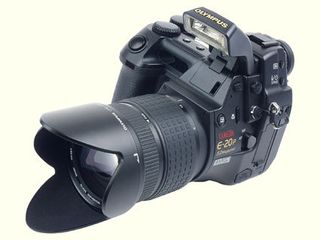Four 5-Megapixel Cameras In Review
Olympus E-20
Like the E-10 before it, the E-20 is the only 5 megapixel really in the twin category. Based on the SLR principle, it is both a general upscale camera and a professional starter-level camera.

Conspicuous, But So Efficient
The E-20 is the 5 megapixel version of the E-10 released a year earlier. The body is the same - sturdy black metal. As opposed to the unobtrusive Coolpix 5000, the E-20 beats all size records for an all-purpose digital camera. Olympus took this opportunity to position the settings over the entire surface. Inside the grip is the power supply (4 AA batteries), and outside the grip are the most frequently-used functions, like the shutter release and the P, A, S and M modes. There is also an LCD display indicating the settings (recording format, white balance, metering, aperture, shutter speed, flash, available memory, exposure). The main jog-dial control is just below the shutter release, next to the white balance. There is another jog-dial at the back, for changing the aperture in manual mode.
In addition to its viewfinder, the best features are the zoom and focus control rings. Their ease of use for shutter speed and control is beyond anything the Nikon and Sony electronic controls can provide.
The TFT monitor at the back is mounted on a device which can be tipped vertical to the camera.
Like the E-10, the E-20 takes SmartMedia or Compact Flash cards. Slots are provided for both. This gives the E-20 an advantage: it is compatible with IBM Microdrives. The E-10 is not supposed to be, though we have been working with an E-10 for some time and a 1 GB Microdrive for the last two months.
Stay on the Cutting Edge
Join the experts who read Tom's Hardware for the inside track on enthusiast PC tech news — and have for over 25 years. We'll send breaking news and in-depth reviews of CPUs, GPUs, AI, maker hardware and more straight to your inbox.
Most Popular

